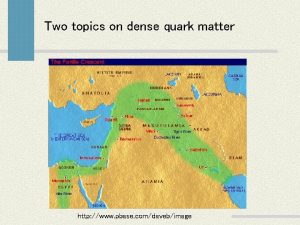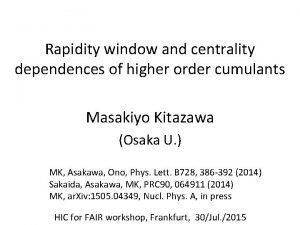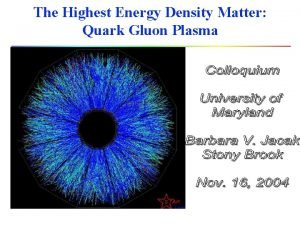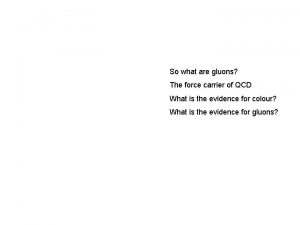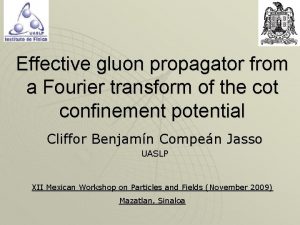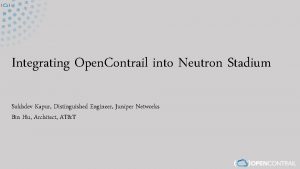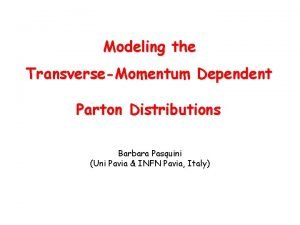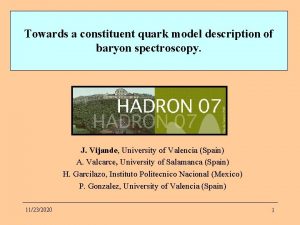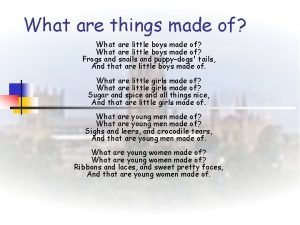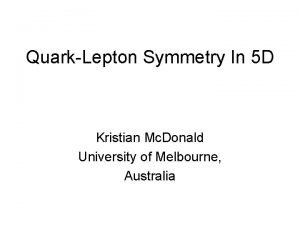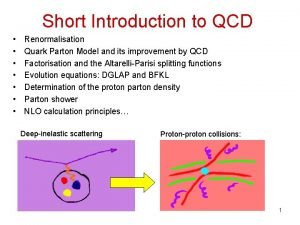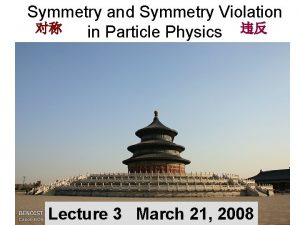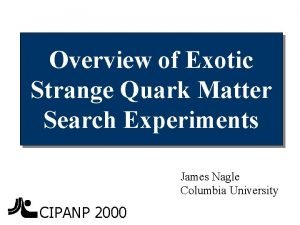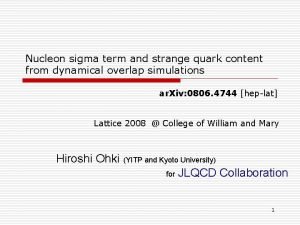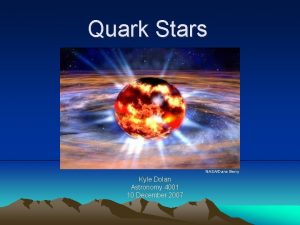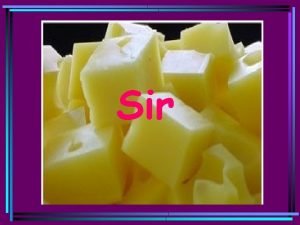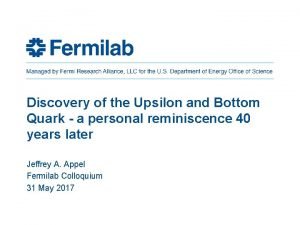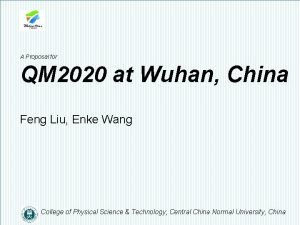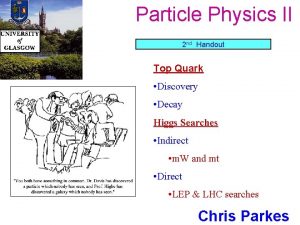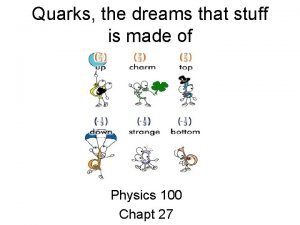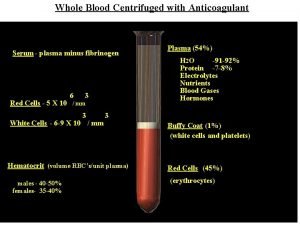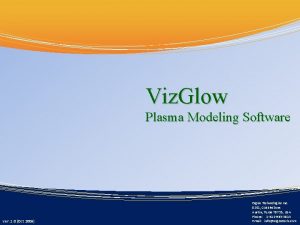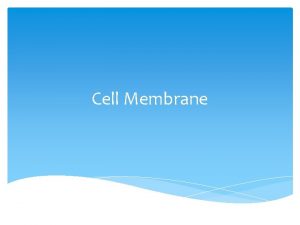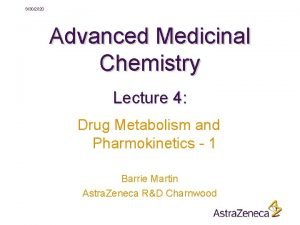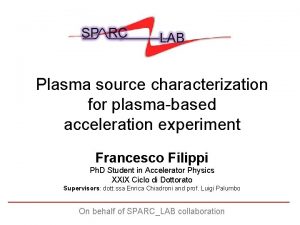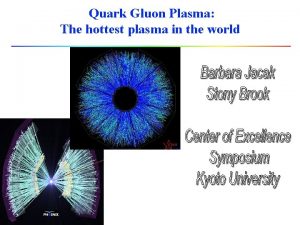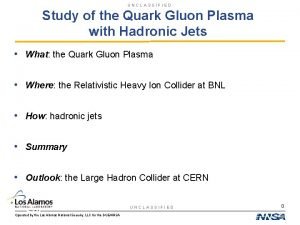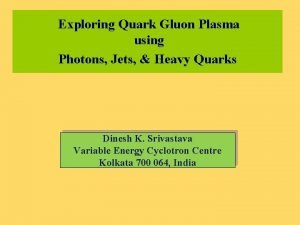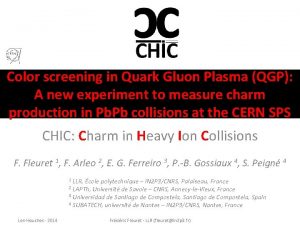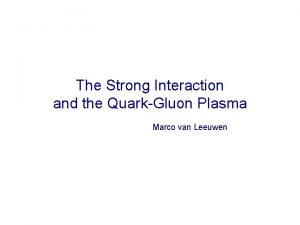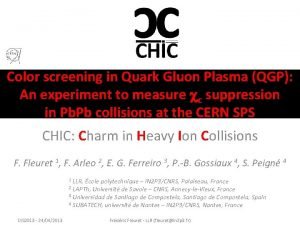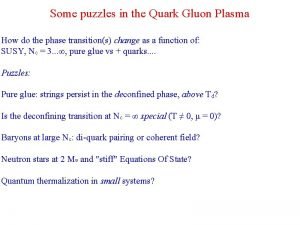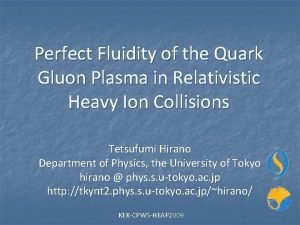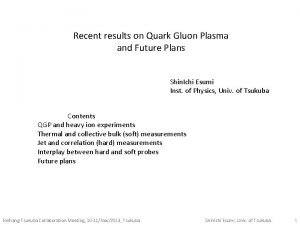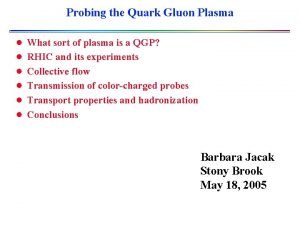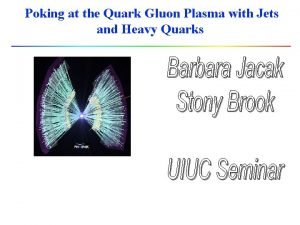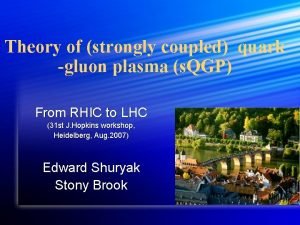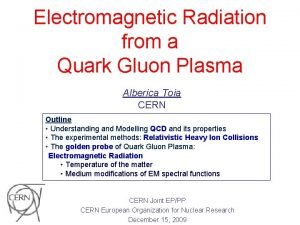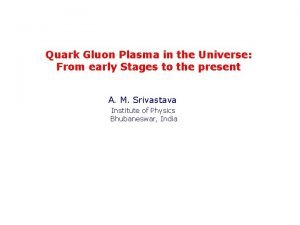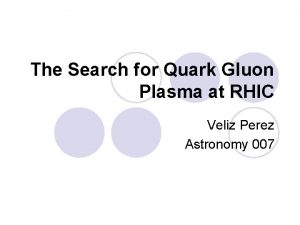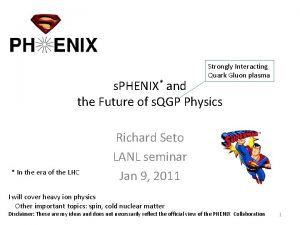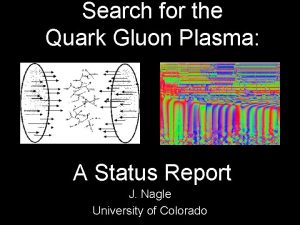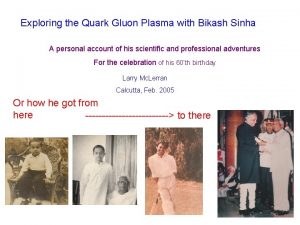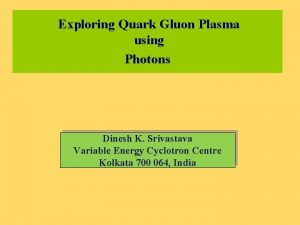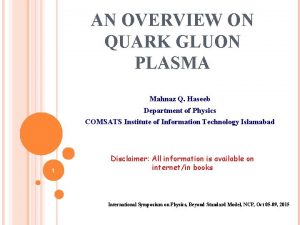Quark Gluon Plasma What do we study Quark




































- Slides: 36

Quark Gluon Plasma

What do we study Quark. Gluon Plasma? ?

meson baryon Gluons Glue the quark together pion u

Quarks are Confined inside Particles Electromagnetic Interaction • Force (r) ~ 1/r 2 • Two charges can be broken apart and set free Strong Interaction (QCD) • Strong interaction is mediated by gluons • Both gluons and quarks has “color” charge. • V(r) = -k 1/r + k 2 r, k 2 1 Ge. V / fm, constant force. As two quarks are pulling away, energy increase. Color string fragment into new pairs of quark. Single quarks are confined inside particles. When energy is high enough, it forms a jet.

How to Liberate Quarks and Gluons Increase Temperature and/or Pressure 1, 500, 000, 000 K ~100, 000 times higher temperature than the center of our sun. Librated Quarks and Gluons Water molecule is liberated with high T and P

Relativistic Heavy Ion Collider

Motivation for Studying Heavy Quarks Heavy quark masses are an external parameter to QCD. Sensitive to initial gluon density and gluon distribution. Energy loss feature different from light quarks. Its suppression and flow capability provide key information on the hot/dense medium properties. Suppression or enhancement pattern of heavy quarkonium production reveal critical features of the medium. Cold Nuclear effect (CNM): Different scaling properties in central and forward rapidity region CGC. Gluon shadowing, etc

Construction of a CMOS APS Pixel -Only electrons that make it to the N-well region will contribute to the signal. -Electrons move randomly (Brownian Motion) through the pixel. -Simulation of Brownian Motion is very slow.

The Fast Simulation -LUT generate from full simulation -Create a grid system based on the geometry of the pixel. -Generate a track. -The number of electrons generated for a single track depends on the Bischel function. -Randomly generate electrons along the track and determine the closest grid point. -Use the lookup table to figure out where a single electron goes. -Add up the contribution of every electron to produce a signal.

The Fast Simulation -LUT generate from full simulation Y X Z -Create a grid system based on the geometry of the pixel.

The Fast Simulation -The number of electrons generated for a single track depends on the Bischel function. -Randomly generate electrons along the track and determine the closest grid point.

Example of a Signal

Direct Comparison At (4, 3, 7) 10, 000 electrons 2 out of 81 were outside 3 sigma 100, 000 electrons 0 out of 81 were outside 3 sigma

Direct Cognitive Comparison At (4, 3, 7) 10, 000 electrons 2 out of 81 were outside 3 sigma 100, 000 electrons 0 out of 81 were outside 3 sigma

Direct Grid Comparison Between (9, 1, 2) and (10, 2, 3) 0. 000001+halfway (<1%) along diagonal => (10, 2, 3) 10, 000 electrons 0 out of 87 were outside 3 sigma 100, 000 electrons 0 out of 87 were outside 3 sigma

Direct Grid Comparison Between (9, 1, 2) and (10, 2, 3) 0. 000001 -halfway (<1%) along diagonal => (9, 1, 2) 10, 000 electrons 1 out of 83 were outside 3 sigma 100, 000 electrons 0 out of 83 were outside 3 sigma

Track Comparison 118, 409 electrons (0. 001104, 0. 00185)->(-0. 00612, 0. 0009) 132, 549 electrons 45 out of 175 were outside 3 sigma (-0. 0092, 0. 0001)->(0. 001472, -0. 0011) 41 out of 191 were outside 3 sigma

Ongoing Efforts and Future Plans Regenerate the LUT using the final pixel dimensions. Study the clustering algorithm to check the pixel detector position.

How to “Detect” quarks The Distance of Closest Approach is used to determine if a quark Is light or heavy.

Heavy Flavor Silicon Tracker Upgrade: the core of RHIC-II heavy flavor program • Pixel size: 18 microns x 18 microns • Number of pixels: 640 x 640 array • Final size of a pixel may be smaller.

How Heavy Quark Come into the Stage? Up Down Strange 4 to 8 Me. V 80 to 130 Me. V Charm 1, 150 to 1, 350 Me. V Bottom 4, 100 to 4, 400 Me. V Top • 1. 5 to 4 Me. V 178, 000 ± 4, 300 Me. V Heavy Quark is ~1000 times heavier than light quark • less energy loss than light quarks Quark energy

Direct Comparison At (10, 1, 2) 10, 000 electrons 0 out of 81 were outside 3 sigma 100, 000 electrons 1 out of 81 were outside 3 sigma

Direct Comparison At (5, 6, 8) 10, 000 electrons 0 out of 81 were outside 3 sigma 100, 000 electrons 0 out of 81 were outside 3 sigma

Table Comparison: (4, 3, 7): 10, 000 electrons

Table Comparison: (4, 3, 7): 10, 000 electrons Error range: 2. 5% - 31. 6%

Table Comparison: (10, 1, 2): 10, 000 electrons Error range: 0. 084% - 1%

Table Comparison: (10, 1, 2): 10, 000 electrons

Table Comparison (Cognitive): (4, 3, 7): 10, 000 electrons

Table Comparison (Cognitive): (10, 1, 2): 10, 000 electrons

Track Comparison 10, 000 Electrons Chi-square: 232 => ? % Confidence Interval Input coordinates (x 1, z 1)->(x 2, z 2): (0. 001, -0. 0014)->(0. 0006, 0. 003)

Track Comparison 2 About 16. 5% error in highest peaks. But this is less than 1% of total electrons (5, 000). Input coordinates (x 1, z 1)->(x 2, z 2): (0. 007, 0. 007)->(0. 007, 0. 007)


Different Types of Collisions p+p -Different collisions yield different results: -p(d) + p(d) -p(d) + Au -Au + Au d+Au Au+Au time -The centrality also contributes to production.

Detecting Tracks beam particle tracks -When two gold nuclei hit, charged particles exit the medium. -The particle tracks are bent by the large magnetic field present.

Grid point Comparison 1, 001 Electrons Chi-square: 31 => 97. 5% Confidence Interval

Cognitive Transform Comparison 1, 001 Electrons Chi-square: 35 => Greater than 99. 5% Confidence Interval
 Quark gluon
Quark gluon Quark gluon plasma
Quark gluon plasma Quark gluon plasma
Quark gluon plasma Quark gluon
Quark gluon What are gluons
What are gluons Gluon propagator
Gluon propagator Gluon plugin
Gluon plugin Quark model
Quark model Constituent quark model
Constituent quark model Quark names
Quark names Quark physics wordle
Quark physics wordle Quark lepton symmetry
Quark lepton symmetry Quark parton model
Quark parton model A charm quark has a charge of approximately
A charm quark has a charge of approximately Color quarks
Color quarks Sigma quark composition
Sigma quark composition Quark astronomy
Quark astronomy Zamjena za quark sir
Zamjena za quark sir Quark names
Quark names Quark matter 2022
Quark matter 2022 Top quark decay
Top quark decay Quark types
Quark types Case series
Case series Study to study
Study to study Retrospective cohort study
Retrospective cohort study Differentiate between time study and motion study
Differentiate between time study and motion study What is work study in management
What is work study in management Difference between time study and motion study
Difference between time study and motion study Study less study smart
Study less study smart Plasma minus fibrinogen
Plasma minus fibrinogen Plasma simulation software
Plasma simulation software Fungsi membran plasma
Fungsi membran plasma Location of cell membrane
Location of cell membrane Plasma protein binding
Plasma protein binding Plasma drug concentration
Plasma drug concentration Enrica chiadroni
Enrica chiadroni Sclera
Sclera
